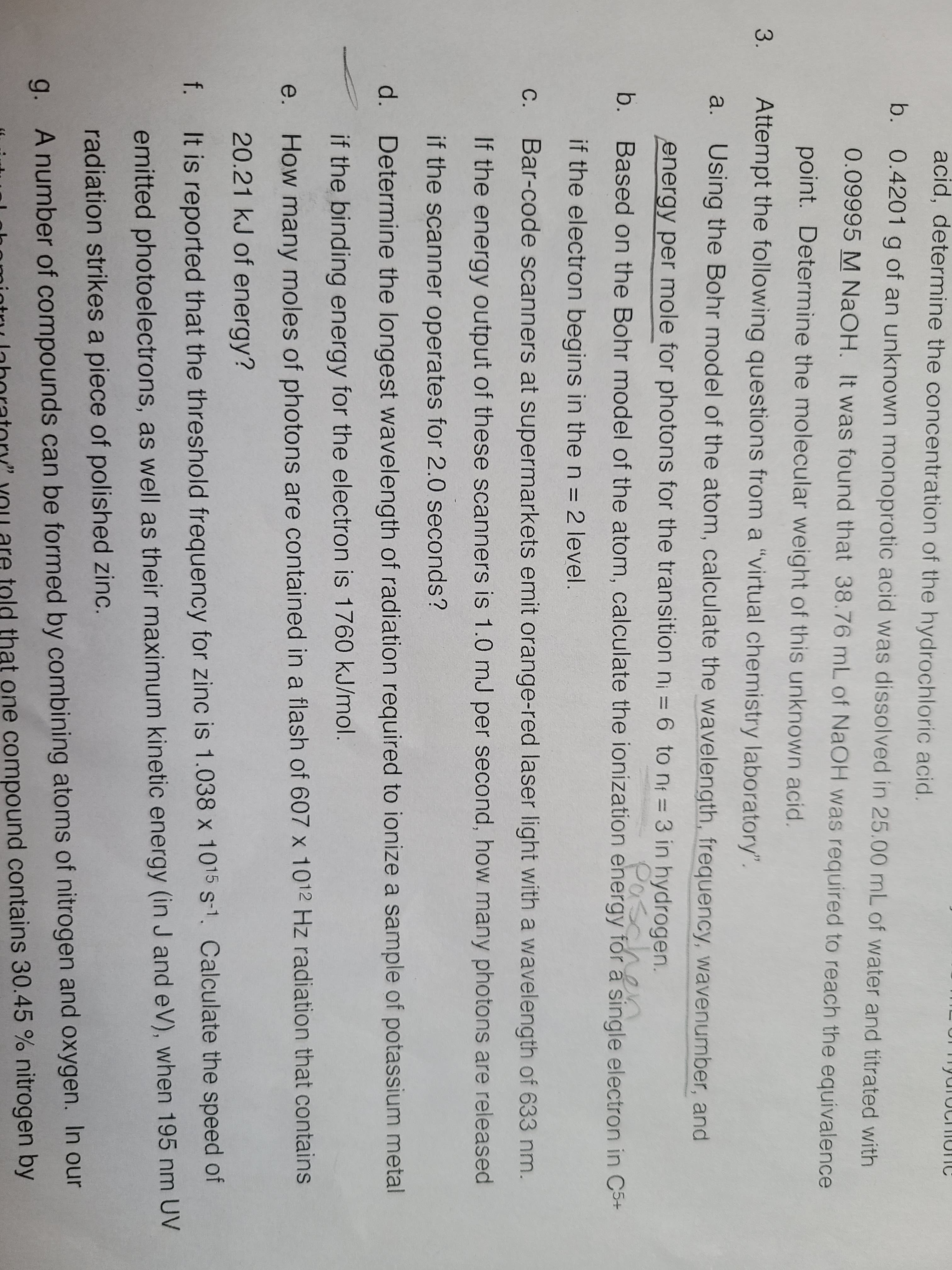= 6 10 Hi = 3 In hydrogen. Paschen b. Based on the Bohr model of the atom, calculate the ionization energy for a single IS TO Eicrgy Per mule lUI photunsS TUI the trdlisitiun i 6o N = 3 In hydrogen. if the electron begins in the n = 2 level. %3D
= 6 10 Hi = 3 In hydrogen. Paschen b. Based on the Bohr model of the atom, calculate the ionization energy for a single IS TO Eicrgy Per mule lUI photunsS TUI the trdlisitiun i 6o N = 3 In hydrogen. if the electron begins in the n = 2 level. %3D
Chemistry: Principles and Practice
3rd Edition
ISBN:9780534420123
Author:Daniel L. Reger, Scott R. Goode, David W. Ball, Edward Mercer
Publisher:Daniel L. Reger, Scott R. Goode, David W. Ball, Edward Mercer
Chapter16: Reactions Between Acids And Bases
Section: Chapter Questions
Problem 16.9QE
Related questions
Question
how do i do 3b?

Transcribed Image Text:acid, determine the concentration of the hydrochloric acid.
b. 0.4201 g of an unknown monoprotic acid was dissolved in 25.00 mL of water and titrated with
0.09995 M NaOH. It was found that 38.76 mL of NaOH was required to reach the equivalence
point. Determine the molecular weight of this unknown acid.
3.
Attempt the following questions from a "virtual chemistry laboratory".
a.
Using the Bohr model of the atom, calculate the wavelength, frequency, wavenumber, and
energy per mole for photons for the transition ni = 6 to nt = 3 in hydrogen.
Pasche
%3D
b.
Based on the Bohr model of the atom, calculate the ionization energy for a single electron in C5+
if the electron begins in the n = 2 level.
%3D
С.
Bar-code scanners at supermarkets emit orange-red laser light with a wavelength of 633 nm.
If the energy output of these scanners is 1.0 mJ per second, how many photons are released
if the scanner operates for 2.0 seconds?
d.
Determine the longest wavelength of radiation required to ionize a sample of potassium metal
if the binding energy for the electron is 1760 kJ/mol.
How many moles of photons are contained in a flash of 607 x 1012 Hz radiation that contains
20.21 kJ of energy?
f.
It is reported that the threshold frequency for zinc is 1.038 x 1015 s-1. Calculate the speed of
emitted photoelectrons, as well as their maximum kinetic energy (in J and eV), when 195 nm UV
radiation strikes a piece of polished zinc.
g. A number of compounds can be formed by combining atoms of nitrogen and oxygen. In our
intru lahoratory" You are told that one compound contains 30.45 % nitrogen by
e.
Expert Solution
This question has been solved!
Explore an expertly crafted, step-by-step solution for a thorough understanding of key concepts.
This is a popular solution!
Trending now
This is a popular solution!
Step by step
Solved in 2 steps with 1 images

Recommended textbooks for you

Chemistry: Principles and Practice
Chemistry
ISBN:
9780534420123
Author:
Daniel L. Reger, Scott R. Goode, David W. Ball, Edward Mercer
Publisher:
Cengage Learning

Principles of Modern Chemistry
Chemistry
ISBN:
9781305079113
Author:
David W. Oxtoby, H. Pat Gillis, Laurie J. Butler
Publisher:
Cengage Learning

Chemistry: Principles and Practice
Chemistry
ISBN:
9780534420123
Author:
Daniel L. Reger, Scott R. Goode, David W. Ball, Edward Mercer
Publisher:
Cengage Learning

Principles of Modern Chemistry
Chemistry
ISBN:
9781305079113
Author:
David W. Oxtoby, H. Pat Gillis, Laurie J. Butler
Publisher:
Cengage Learning